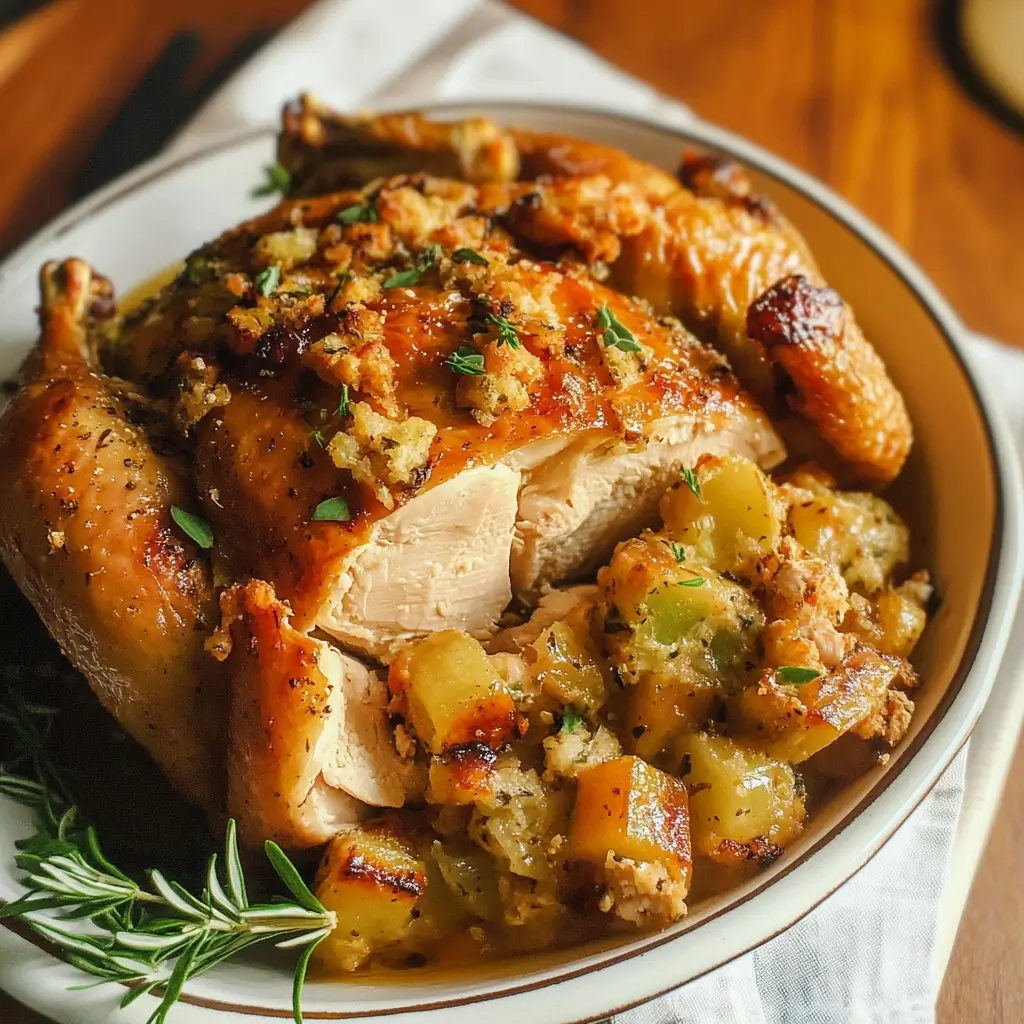There are certain dishes that just scream “comfort” and “celebration” in equal measure, and for my family, Roasted Stuffed Whole Chicken is undoubtedly one of them. From the moment the tantalizing aroma starts to waft through the house, a sense of warmth and anticipation fills the air. This isn’t just dinner; it’s an experience. I remember the first time I made this recipe – a slightly ambitious undertaking for a casual Sunday lunch. I was nervous about getting the chicken cooked through while keeping it moist, and the stuffing flavorful without being soggy. But to my delight, and even more importantly, to my family’s delight, it turned out absolutely perfect. The skin was beautifully golden and crispy, the meat juicy and tender, and the stuffing, oh, the stuffing! It was a symphony of savory flavors and textures that complemented the chicken perfectly. Even my pickiest eater, my youngest son, devoured his portion with gusto, declaring it “the best chicken ever!” Since then, Roasted Stuffed Whole Chicken has become a regular feature on our family table, a dish we turn to for special occasions, cozy weekend dinners, or simply when we crave a hearty and deeply satisfying meal. It’s more than just a recipe; it’s a source of happy memories and shared moments around the dinner table, and I’m thrilled to share this recipe with you, hoping it brings the same joy and deliciousness to your home.
Ingredients
This recipe is incredibly versatile, allowing for adjustments based on your preferences and what you have on hand. Below, I’ve outlined the core ingredients, with suggestions for variations to inspire your culinary creativity.
For the Chicken:
- 1 Whole Chicken (4-5 lbs): Opt for a good quality, fresh whole chicken. A 4-5 pound chicken will comfortably serve 4-6 people. If you are serving a larger crowd, consider roasting two smaller chickens instead of one very large one, as smaller chickens tend to cook more evenly. Look for chickens labeled “air-chilled” for potentially crispier skin.
- 2 Tablespoons Olive Oil: Extra virgin olive oil is preferred for its flavor and health benefits, but any neutral cooking oil like vegetable or canola oil will work. This is used to coat the chicken for even browning and crispy skin.
- 2 Tablespoons Unsalted Butter, softened: Butter adds richness and flavor to the chicken skin. Using softened butter makes it easier to spread evenly. You can use salted butter, but reduce the amount of added salt in the seasoning blend.
- 1 Lemon, halved: One half is for stuffing inside the cavity for aroma and moisture, and the other half is for squeezing juice over the chicken before roasting to brighten the flavors.
- Fresh Herbs (such as Rosemary, Thyme, Sage): A combination of fresh herbs elevates the flavor profile of the roasted chicken. Rosemary, thyme, and sage are classic choices that complement chicken beautifully. Use about 2-3 sprigs of each, or adjust to your liking. Dried herbs can be used in a pinch, but fresh herbs provide a more vibrant and aromatic flavor. Use about 1 teaspoon of dried herb for every tablespoon of fresh herb.
- Salt and Freshly Ground Black Pepper: Essential for seasoning. Kosher salt or sea salt is recommended for its clean taste. Freshly ground black pepper offers a more robust flavor than pre-ground pepper.
- Optional: Garlic Cloves (2-3 cloves), peeled and smashed: Adding smashed garlic cloves to the chicken cavity infuses the chicken with a subtle garlic aroma.
For the Stuffing:
- 1 Tablespoon Olive Oil: Used to sauté the vegetables for the stuffing base.
- 1 Large Onion, chopped: Yellow or white onion works well. Onion forms the aromatic foundation of the stuffing.
- 2-3 Celery Stalks, chopped: Celery adds texture and a subtle savory flavor to the stuffing.
- 2-3 Carrots, chopped: Carrots contribute sweetness and color to the stuffing.
- 8 oz (about 4 cups) Cubed Bread, day-old: Day-old bread is crucial for stuffing. It’s slightly dried out, which prevents the stuffing from becoming soggy. Use a crusty bread like sourdough, baguette, or Italian bread. You can also use cornbread or challah for different flavor profiles. Cut the bread into roughly 1-inch cubes.
- 1 cup Chicken Broth or Stock: Moistens the stuffing and adds flavor. Low-sodium chicken broth is recommended to control the salt level. You can also use vegetable broth or even white wine for a richer flavor.
- ½ cup Fresh Parsley, chopped: Adds freshness and a vibrant green color to the stuffing. Italian flat-leaf parsley is preferred for its robust flavor.
- ½ cup Dried Cranberries or Raisins (optional): Adds a touch of sweetness and chewiness to the stuffing, creating a delightful contrast to the savory flavors. Dried cranberries are a classic choice, but raisins or even chopped dried apricots can be used.
- ½ cup Chopped Nuts (such as Walnuts, Pecans, or Almonds), toasted (optional): Adds crunch and nutty flavor to the stuffing. Toasting the nuts enhances their flavor and texture. Walnuts, pecans, or slivered almonds are good options.
- 1 teaspoon Dried Thyme: Adds a warm, earthy flavor to the stuffing.
- ½ teaspoon Dried Sage: Complements the thyme and adds a classic stuffing flavor.
- ½ teaspoon Dried Rosemary: Adds a piney, aromatic note to the stuffing.
- Salt and Freshly Ground Black Pepper: To season the stuffing.
Variations & Substitutions:
- Bread: For gluten-free stuffing, use gluten-free bread cubes or a mixture of rice and quinoa.
- Vegetables: Add mushrooms, bell peppers, or leeks to the stuffing for extra flavor and nutrition. Sauté them along with the onion, celery, and carrots.
- Herbs: Experiment with different herb combinations. Try adding marjoram, oregano, or chives.
- Fruit & Nuts: Use dried cherries, chopped apples, or pears instead of cranberries/raisins. Try hazelnuts, pistachios, or macadamia nuts instead of walnuts/pecans/almonds.
- Meat in Stuffing: For a richer stuffing, consider adding cooked sausage (Italian sausage or breakfast sausage) or bacon. Brown and crumble the sausage or bacon before adding it to the stuffing mixture.
- Broth: Use bone broth for added nutrients and flavor depth.
- Citrus: Use orange or grapefruit instead of lemon for a different citrus note.
- Spice: Add a pinch of red pepper flakes to the stuffing for a subtle kick.
Instructions
Follow these step-by-step instructions to create a perfectly roasted and stuffed whole chicken that will impress your family and friends.
Preparation (30-45 minutes):
- Preheat Oven and Prepare Baking Pan: Preheat your oven to 400°F (200°C). Position a rack in the center of the oven. Prepare a roasting pan with a roasting rack. If you don’t have a roasting rack, you can use roughly chopped vegetables (like onions, carrots, and celery) to elevate the chicken, which will allow for better air circulation and even cooking.
- Prepare the Chicken: Remove the chicken from its packaging. Remove and discard the giblets and neck from the cavity (or save them for making stock). Pat the chicken thoroughly dry inside and out with paper towels. Drying the chicken skin is crucial for achieving crispy skin.
- Make the Stuffing: In a large skillet or Dutch oven, heat 1 tablespoon of olive oil over medium heat. Add the chopped onion, celery, and carrots and sauté until softened, about 5-7 minutes. Season with salt and pepper.
- Combine Stuffing Ingredients: In a large bowl, combine the sautéed vegetables, cubed day-old bread, chicken broth, chopped parsley, dried cranberries (or raisins, if using), toasted nuts (if using), dried thyme, dried sage, dried rosemary, salt, and pepper. Mix well to combine, ensuring the bread is evenly moistened with the broth. The stuffing should be moist but not soggy. If it seems too dry, add a little more broth, one tablespoon at a time. If it’s too wet, add more bread cubes.
- Stuff the Chicken: Gently spoon the stuffing into the cavity of the chicken. Do not overstuff the chicken, as this can prevent it from cooking evenly and can also lead to soggy stuffing. Leave some space for the stuffing to expand during cooking. If you have leftover stuffing, you can bake it separately in a greased baking dish alongside the chicken during the last 30-40 minutes of roasting.
- Truss the Chicken (Optional but Recommended): Trussing the chicken helps it cook more evenly and maintains a compact shape for a more attractive presentation. Use kitchen twine to tie the legs together and tuck the wing tips under the body of the chicken. If you don’t want to truss, simply tuck the wing tips under the body.
- Prepare the Chicken for Roasting: Place the stuffed and trussed chicken on the prepared roasting rack in the roasting pan. Rub the chicken all over with softened butter, ensuring even coverage. Drizzle with olive oil. Season generously with salt and freshly ground black pepper, ensuring you season all sides of the chicken. Squeeze the juice of half a lemon over the chicken. Place the lemon halves and smashed garlic cloves (if using) inside the chicken cavity with the stuffing.
- Add Herbs to Roasting Pan: Scatter fresh rosemary, thyme, and sage sprigs around the chicken in the roasting pan. This will infuse the chicken and pan drippings with aromatic herb flavors.
Roasting (1 hour 15 minutes – 1 hour 45 minutes):
- Roast at High Heat Initially: Roast the chicken in the preheated oven at 400°F (200°C) for the first 30 minutes. This initial high heat helps to crisp up the skin.
- Reduce Oven Temperature and Continue Roasting: Reduce the oven temperature to 350°F (175°C) and continue roasting for another 45 minutes to 1 hour 15 minutes, or until the chicken is cooked through. The exact roasting time will depend on the size of your chicken and your oven.
- Check for Doneness: The chicken is done when a meat thermometer inserted into the thickest part of the thigh (without touching the bone) registers 165°F (74°C). The juices should run clear when you pierce the thigh with a fork. The legs should also move easily in their sockets.
- Baste the Chicken (Optional): For extra moistness and flavor, you can baste the chicken with the pan drippings every 20-30 minutes during the roasting process.
- Rest the Chicken: Once the chicken is cooked through, remove it from the oven and transfer it to a cutting board. Tent loosely with aluminum foil and let it rest for at least 15-20 minutes before carving. Resting allows the juices to redistribute throughout the chicken, resulting in a more tender and flavorful bird.
Carving and Serving:
- Remove Stuffing (Optional): If desired, carefully remove the stuffing from the chicken cavity before carving. This can make carving easier and prevent the stuffing from getting squished. However, some people prefer to carve with the stuffing inside.
- Carve the Chicken: Carve the chicken into serving pieces. Start by removing the legs and thighs. Then, slice the breast meat.
- Serve: Arrange the carved chicken on a platter. Serve the stuffing alongside. Drizzle the pan juices over the chicken and stuffing.
Nutrition Facts (Estimated)
- Servings: 6-8 (depending on chicken size and serving portions)
- Calories per Serving (estimated): 500-700 calories (This is an estimate and can vary greatly depending on the specific ingredients used, portion size, and whether you include skin and stuffing in the serving.)
Approximate Nutritional Breakdown (per estimated serving, without skin and with a moderate portion of stuffing):
- Protein: 40-50g
- Fat: 25-40g (depending on skin and fat content of chicken and stuffing ingredients)
- Carbohydrates: 30-40g (primarily from stuffing)
- Fiber: 3-5g
Disclaimer: These nutritional values are estimates and should be used as a general guide only. Actual nutritional content will vary based on specific ingredients, portion sizes, and cooking methods. For precise nutritional information, use a nutrition calculator with the specific brands and quantities of ingredients you use.
Preparation Time
- Prep Time: 30-45 minutes (includes chopping vegetables, making stuffing, and prepping chicken)
- Cook Time: 1 hour 15 minutes – 1 hour 45 minutes (depending on chicken size and oven)
- Resting Time: 15-20 minutes
- Total Time: Approximately 2 hours – 2 hours 45 minutes
How to Serve Roasted Stuffed Whole Chicken
Roasted Stuffed Whole Chicken is a versatile dish that pairs beautifully with a variety of side dishes. Here are some serving suggestions to create a complete and satisfying meal:
- Classic Side Dishes:
- Mashed Potatoes: Creamy mashed potatoes are a quintessential pairing with roasted chicken.
- Roasted Vegetables: Roast vegetables like Brussels sprouts, broccoli, carrots, potatoes, or sweet potatoes alongside the chicken for a healthy and flavorful side.
- Green Beans: Sautéed or steamed green beans with garlic and lemon are a simple and elegant side.
- Corn on the Cob or Creamed Corn: Sweet corn complements the savory chicken and stuffing.
- Stuffing (Served Separately): If you have extra stuffing baked separately, serve it alongside the chicken.
- Salads:
- Green Salad with Vinaigrette: A light and fresh green salad provides a nice contrast to the richness of the chicken.
- Caesar Salad: A classic Caesar salad adds a creamy and tangy element.
- Winter Salad with Roasted Butternut Squash and Cranberries: A seasonal salad with roasted butternut squash, cranberries, and pecans complements the flavors of the stuffing.
- Grains and Starches:
- Rice Pilaf: A flavorful rice pilaf adds another layer of texture and taste.
- Quinoa Salad: A healthy quinoa salad with vegetables and herbs is a nutritious side option.
- Bread Rolls or Biscuits: Serve warm bread rolls or biscuits to soak up the delicious pan juices.
- Sauces and Gravies:
- Pan Gravy: Make a simple pan gravy from the chicken drippings for a classic accompaniment.
- Cranberry Sauce: Cranberry sauce adds a festive and tangy element, especially during holidays.
- Apple Chutney or Relish: A sweet and savory apple chutney or relish complements the chicken beautifully.
- Serving Occasions:
- Sunday Dinner: Roasted Stuffed Whole Chicken is a perfect centerpiece for a cozy Sunday dinner.
- Holiday Meals: It’s a classic dish for Thanksgiving, Christmas, Easter, or other special occasions.
- Family Gatherings: Impress your family and friends with this flavorful and satisfying meal.
- Special Occasions: Celebrate birthdays, anniversaries, or other milestones with this elegant dish.
Presentation Tips:
- Garnish: Garnish the platter with fresh herbs like rosemary sprigs or parsley for a visually appealing presentation.
- Carving Station: Set up a carving station with the whole roasted chicken and let guests serve themselves.
- Plating: Arrange carved chicken pieces and stuffing artfully on individual plates.
- Serving Dishes: Use attractive serving dishes to enhance the visual appeal of the meal.
Additional Tips for Perfect Roasted Stuffed Whole Chicken
Achieving perfectly roasted and stuffed chicken is easier than you might think with these helpful tips:
- Brine Your Chicken for Extra Moisture: Brining the chicken in a saltwater solution for a few hours or overnight before roasting will result in incredibly juicy and flavorful meat. A simple brine consists of water, salt, and sugar. You can find many brine recipes online. Brining helps the chicken retain moisture during cooking, preventing it from drying out.
- Use a Meat Thermometer – It’s Your Best Friend: Don’t rely solely on cooking time. A meat thermometer is essential for ensuring your chicken is cooked to the perfect internal temperature of 165°F (74°C). Insert the thermometer into the thickest part of the thigh, avoiding the bone, for an accurate reading. Overcooked chicken is dry, while undercooked chicken is unsafe.
- Don’t Overstuff the Chicken: While a generous amount of stuffing is desirable, avoid overpacking the chicken cavity. Overstuffing can prevent the chicken from cooking evenly, and the stuffing in the center may not reach a safe temperature. It can also make the stuffing soggy and dense. Leave some room for the stuffing to expand as it cooks.
- Rest is Key for Juiciness: Resist the urge to carve the chicken immediately after taking it out of the oven. Resting the chicken, tented loosely with foil, for 15-20 minutes allows the juices to redistribute throughout the meat, resulting in a more tender and flavorful chicken. This step is crucial for preventing dry chicken.
- Get Creative with Stuffing Variations: Don’t be afraid to experiment with different stuffing ingredients to create unique flavor combinations. Try adding wild rice, sausage, apples, dried apricots, mushrooms, or different herbs and spices to your stuffing. Tailor the stuffing to your taste preferences and the season.
FAQ Section: Roasted Stuffed Whole Chicken
Q1: Can I prepare the stuffing ahead of time?
A: Yes, you can prepare the stuffing a day ahead of time. Cook the vegetables and combine all the stuffing ingredients, but do not stuff the chicken until you are ready to roast it. Store the prepared stuffing in an airtight container in the refrigerator. This can save you time on the day of cooking. However, ensure the stuffing is chilled before stuffing the chicken to maintain food safety.
Q2: Is it safe to stuff a chicken?
A: Yes, it is safe to stuff a chicken as long as you follow proper food safety guidelines. The most important thing is to ensure that the stuffing reaches a safe internal temperature of 165°F (74°C) to kill any potential bacteria. Use a meat thermometer to check the temperature of both the chicken and the stuffing in the center of the cavity. Do not stuff the chicken too far in advance and always refrigerate any leftover stuffed chicken promptly.
Q3: Can I roast the chicken at a lower temperature for longer?
A: Yes, you can roast the chicken at a lower temperature, such as 325°F (160°C), for a longer period. This method can result in even more tender chicken. However, it will take longer to cook, and the skin may not be as crispy. If roasting at a lower temperature, ensure you still use a meat thermometer to confirm the chicken is cooked to 165°F (74°C). You may also need to increase the roasting time by about 30-45 minutes.
Q4: What can I do if my chicken skin isn’t crispy?
A: To ensure crispy chicken skin, start by patting the chicken thoroughly dry before seasoning. Roasting at a higher temperature initially (400°F/200°C for the first 30 minutes) helps crisp the skin. You can also increase the oven temperature to 425°F (220°C) for the last 15-20 minutes of roasting to further crisp the skin, but watch carefully to prevent burning. Basting with butter or oil can also contribute to crispy skin. Air-chilled chicken tends to have crispier skin as well.
Q5: How do I store leftover roasted stuffed chicken?
A: Store leftover roasted stuffed chicken promptly in the refrigerator within two hours of cooking. Remove the stuffing from the chicken and store it separately in an airtight container. Store the chicken in another airtight container or wrap it tightly in plastic wrap. Leftover roasted chicken and stuffing are best consumed within 3-4 days. Reheat thoroughly to an internal temperature of 165°F (74°C) before serving. You can reheat in the oven, microwave, or skillet.
Print
Roasted Stuffed Whole Chicken Recipe
Ingredients
For the Chicken:
- 1 Whole Chicken (4–5 lbs): Opt for a good quality, fresh whole chicken. A 4-5 pound chicken will comfortably serve 4-6 people. If you are serving a larger crowd, consider roasting two smaller chickens instead of one very large one, as smaller chickens tend to cook more evenly. Look for chickens labeled “air-chilled” for potentially crispier skin.
- 2 Tablespoons Olive Oil: Extra virgin olive oil is preferred for its flavor and health benefits, but any neutral cooking oil like vegetable or canola oil will work. This is used to coat the chicken for even browning and crispy skin.
- 2 Tablespoons Unsalted Butter, softened: Butter adds richness and flavor to the chicken skin. Using softened butter makes it easier to spread evenly. You can use salted butter, but reduce the amount of added salt in the seasoning blend.
- 1 Lemon, halved: One half is for stuffing inside the cavity for aroma and moisture, and the other half is for squeezing juice over the chicken before roasting to brighten the flavors.
- Fresh Herbs (such as Rosemary, Thyme, Sage): A combination of fresh herbs elevates the flavor profile of the roasted chicken. Rosemary, thyme, and sage are classic choices that complement chicken beautifully. Use about 2-3 sprigs of each, or adjust to your liking. Dried herbs can be used in a pinch, but fresh herbs provide a more vibrant and aromatic flavor. Use about 1 teaspoon of dried herb for every tablespoon of fresh herb.
- Salt and Freshly Ground Black Pepper: Essential for seasoning. Kosher salt or sea salt is recommended for its clean taste. Freshly ground black pepper offers a more robust flavor than pre-ground pepper.
- Optional: Garlic Cloves (2-3 cloves), peeled and smashed: Adding smashed garlic cloves to the chicken cavity infuses the chicken with a subtle garlic aroma.
For the Stuffing:
- 1 Tablespoon Olive Oil: Used to sauté the vegetables for the stuffing base.
- 1 Large Onion, chopped: Yellow or white onion works well. Onion forms the aromatic foundation of the stuffing.
- 2–3 Celery Stalks, chopped: Celery adds texture and a subtle savory flavor to the stuffing.
- 2–3 Carrots, chopped: Carrots contribute sweetness and color to the stuffing.
- 8 oz (about 4 cups) Cubed Bread, day-old: Day-old bread is crucial for stuffing. It’s slightly dried out, which prevents the stuffing from becoming soggy. Use a crusty bread like sourdough, baguette, or Italian bread. You can also use cornbread or challah for different flavor profiles. Cut the bread into roughly 1-inch cubes.
- 1 cup Chicken Broth or Stock: Moistens the stuffing and adds flavor. Low-sodium chicken broth is recommended to control the salt level. You can also use vegetable broth or even white wine for a richer flavor.
- ½ cup Fresh Parsley, chopped: Adds freshness and a vibrant green color to the stuffing. Italian flat-leaf parsley is preferred for its robust flavor.
- ½ cup Dried Cranberries or Raisins (optional): Adds a touch of sweetness and chewiness to the stuffing, creating a delightful contrast to the savory flavors. Dried cranberries are a classic choice, but raisins or even chopped dried apricots can be used.
- ½ cup Chopped Nuts (such as Walnuts, Pecans, or Almonds), toasted (optional): Adds crunch and nutty flavor to the stuffing. Toasting the nuts enhances their flavor and texture. Walnuts, pecans, or slivered almonds are good options.
- 1 teaspoon Dried Thyme: Adds a warm, earthy flavor to the stuffing.
- ½ teaspoon Dried Sage: Complements the thyme and adds a classic stuffing flavor.
- ½ teaspoon Dried Rosemary: Adds a piney, aromatic note to the stuffing.
- Salt and Freshly Ground Black Pepper: To season the stuffing.
Instructions
Preparation (30-45 minutes):
- Preheat Oven and Prepare Baking Pan: Preheat your oven to 400°F (200°C). Position a rack in the center of the oven. Prepare a roasting pan with a roasting rack. If you don’t have a roasting rack, you can use roughly chopped vegetables (like onions, carrots, and celery) to elevate the chicken, which will allow for better air circulation and even cooking.
- Prepare the Chicken: Remove the chicken from its packaging. Remove and discard the giblets and neck from the cavity (or save them for making stock). Pat the chicken thoroughly dry inside and out with paper towels. Drying the chicken skin is crucial for achieving crispy skin.
- Make the Stuffing: In a large skillet or Dutch oven, heat 1 tablespoon of olive oil over medium heat. Add the chopped onion, celery, and carrots and sauté until softened, about 5-7 minutes. Season with salt and pepper.
- Combine Stuffing Ingredients: In a large bowl, combine the sautéed vegetables, cubed day-old bread, chicken broth, chopped parsley, dried cranberries (or raisins, if using), toasted nuts (if using), dried thyme, dried sage, dried rosemary, salt, and pepper. Mix well to combine, ensuring the bread is evenly moistened with the broth. The stuffing should be moist but not soggy. If it seems too dry, add a little more broth, one tablespoon at a time. If it’s too wet, add more bread cubes.
- Stuff the Chicken: Gently spoon the stuffing into the cavity of the chicken. Do not overstuff the chicken, as this can prevent it from cooking evenly and can also lead to soggy stuffing. Leave some space for the stuffing to expand during cooking. If you have leftover stuffing, you can bake it separately in a greased baking dish alongside the chicken during the last 30-40 minutes of roasting.
- Truss the Chicken (Optional but Recommended): Trussing the chicken helps it cook more evenly and maintains a compact shape for a more attractive presentation. Use kitchen twine to tie the legs together and tuck the wing tips under the body of the chicken. If you don’t want to truss, simply tuck the wing tips under the body.
- Prepare the Chicken for Roasting: Place the stuffed and trussed chicken on the prepared roasting rack in the roasting pan. Rub the chicken all over with softened butter, ensuring even coverage. Drizzle with olive oil. Season generously with salt and freshly ground black pepper, ensuring you season all sides of the chicken. Squeeze the juice of half a lemon over the chicken. Place the lemon halves and smashed garlic cloves (if using) inside the chicken cavity with the stuffing.
- Add Herbs to Roasting Pan: Scatter fresh rosemary, thyme, and sage sprigs around the chicken in the roasting pan. This will infuse the chicken and pan drippings with aromatic herb flavors.
Roasting (1 hour 15 minutes – 1 hour 45 minutes):
- Roast at High Heat Initially: Roast the chicken in the preheated oven at 400°F (200°C) for the first 30 minutes. This initial high heat helps to crisp up the skin.
- Reduce Oven Temperature and Continue Roasting: Reduce the oven temperature to 350°F (175°C) and continue roasting for another 45 minutes to 1 hour 15 minutes, or until the chicken is cooked through. The exact roasting time will depend on the size of your chicken and your oven.
- Check for Doneness: The chicken is done when a meat thermometer inserted into the thickest part of the thigh (without touching the bone) registers 165°F (74°C). The juices should run clear when you pierce the thigh with a fork. The legs should also move easily in their sockets.
- Baste the Chicken (Optional): For extra moistness and flavor, you can baste the chicken with the pan drippings every 20-30 minutes during the roasting process.
- Rest the Chicken: Once the chicken is cooked through, remove it from the oven and transfer it to a cutting board. Tent loosely with aluminum foil and let it rest for at least 15-20 minutes before carving. Resting allows the juices to redistribute throughout the chicken, resulting in a more tender and flavorful bird.
Carving and Serving:
- Remove Stuffing (Optional): If desired, carefully remove the stuffing from the chicken cavity before carving. This can make carving easier and prevent the stuffing from getting squished. However, some people prefer to carve with the stuffing inside.
- Carve the Chicken: Carve the chicken into serving pieces. Start by removing the legs and thighs. Then, slice the breast meat.
- Serve: Arrange the carved chicken on a platter. Serve the stuffing alongside. Drizzle the pan juices over the chicken and stuffing.
Nutrition
- Serving Size: one normal portion
- Calories: 500-700
- Fat: 25-40g
- Carbohydrates: 30-40g
- Fiber: 3-5g
- Protein: 40-50g





